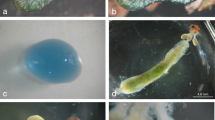Abstract
Although metabolites of furanocoumarins have been characterized in a wide range of organisms, to date they have been identified in only a single insect species, Papilio polyxenes. Depressaria pastinacella, the parsnip webworm, like P. polyxenes a specialist on Apiaceae, routinely consumes plant tissues higher in furanocoumarin content than does P. polyxenes and is capable of faster cytochrome P-450-mediated detoxification of these compounds. In this study, we characterized metabolites of xanthotoxin, a linear furanocoumarin, and sphondin, an angular furanocoumarin, in midguts and frass of parsnip webworms. Two metabolites were isolated and identified from webworms fed artificial diet containing xanthotoxin. LC-ESI-MS analysis resulted in the determination of a MW of 266 for the compound in the frass and one of the compounds in the midgut; 1H NMR confirmed its structure as 6-(7-hydroxy-8-methoxycoumaryl)-hydroxyacetic acid (HCHA). The second compound from the midgut had a MW of 252 and was identified by 1H NMR and 13C NMR analysis as 6-(7-hydroxy-8-methoxycoumaryl)-hydroxyethanol) (HMCH). Whereas HCHA has been found in frass of Papilio polyxenes fed xanthotoxin, HMCH has not been reported previously in insects. Although the first step of metabolism of xanthotoxin in webworms as well as P. polyxenes is likely the formation of an epoxide on the furan ring, angular furanocoumarin metabolism in webworms appears to differ. The principal metabolite of sphondin was identified as demethylated sphondin (6-hydroxy-2H-furo[2,3-h]-1-benzopyran-2-one) by LC-ESI-MS and confirmed by 1H NMR and 13C NMR analyses. That webworms produce metabolites of xanthotoxin in common not only with other Lepidoptera (e.g., HCHA) but with other vertebrates (e.g., HMCH) suggests a remarkable conservatism in the metabolic capabilities of cytochrome P-450s and raises the possibility that insects may share other detoxification reactions with vertebrates with respect to toxins in foodplants.
Similar content being viewed by others
References
Berenbaum, M. R. 1991. Coumarins, pp. 221–249, in G. Rosenthal and M. Berenbaum (Eds.). Herbivores, Their Interactions with Secondary Plant Metabolites, Vol. 1. Academic Press, New York.
Berenbaum, M. R. 1995. Phototoxicity of plant secondary metabolites; insect and mammalian perspectives. Arch. Insect Biochem Physiol. 29:119–134.
Berenbaum, M. R. 2002. Post-genomic chemical ecology; from genetic code to ecological interactions. J. Chem. Ecol. 28:873–897.
Berenbaum, M. R. and Zangerl, A. R. 1992. Genetics of physiological and behavioral resistance to host furanocoumarins in the parsnip webworm. Evolution 46:1373–1384.
Berenbaum, M. R. and Zangerl, A. R. 1996. Phytochemical diversity: adaptation or random variation?. Recent Adv. Phytochem 30:1–24.
Berenbaum, M. R. and Zangerl, A. R. 1998. Chemical phenotype matching between a plant and its insect herbivore. Proc. Natl. Acad. Sci. U.S.A. 95:13743–13748.
Bernays, E. A., and Graham, M. 1988 On the evolution of host specificity in phytophagous arthropods. Ecology 69:886–892.
Bull, D. L., Ivie, G. W., Beier, R. C., Pryor, N. W., and Oerti, E. H. 1984. Fate of photosensitizing furanocoumarins in tolerant and sensitive insects. J. Chem. Ecol. 10:893–911.
Cianfrogna, J., Zangerl, A. R., and Berenbaum, M. R. 2002. Dietary and developmental effects on furanocoumarin detoxification in an oligophagous insect. J. Chem. Ecol. 28:1349–1364.
Cohen, M. B., Berenbaum, M. R., and Schuler, M. A. 1989. Induction of cytochrome P-450–mediated detoxification in the black swallowtail. J. Chem. Ecol. 15:2347–2355.
Cohen, M. B., Schuler, M. A., and Berenbaum, M. R. 1992. A host-inducible cytochrome P-450 from a host-specific caterpillar: molecular cloning and evolution. Proc. Nat. Acad. Sci. U.S.A. 89:10920–10924.
Ivie, G. W. 1987. Biological actions and metabolic transformations of furanocoumarins. pp. 216–230 in J. E. Heitz and K. R. Downum (Eds.). Light-Activated Pesticides. ACS Symposium Series 339. American Chemical Society, Washington D.C.
Ivie, G. W., Bull, D. L., Beier, R. C., Pryor, N. W., and Oertli, E. H. 1983. Metabolic detoxification: mechanism of insect resistance to plant psoralens. Science 221:374–376.
Ivie, G. W., Beier, R. C., Bull, D. L., and Oertli, D. V. D. 1986a. Fate of [14C]xanthotoxin (8–methoxypsoralen) in goat and in bovine ruminal fluid. Am. J. Vet. Res. 47:799–803.
Ivie, G. W., Bull, D. L., Beier, R. C., and Pryor, N. W. 1986b. Comparative metabolism of [3H]psoralen and [3H]ispsoralen by black swallowtail buttterfly (Papilio polyxenes Fabr.) caterpillars. J. Chem. Ecol. 11:869–882.
Koenigs, L. L. and Trager, W. F. 1998a. Mechanism based inactivation of P-450 2A6 by furanocoumarins. Biochemistry 37:10047–10061.
Koenigs, L. L. and Trager, W. F. 1998b. Mechanism based inactivation of cytochrome P-450 2B1 by 8–methoxypsorlen and several other furanocoumarins. Biochemistry 37:13184–13193.
Ma, R., Cohen, M. B., Berenbaum, M. R., and Schuler, M. A. 1994. Black swallowtail (Papilio polyxenes) alleles encode cytochrome P450s that selectively metabolize linear furanocoumarins. Arch. Biochem. Biophys. 310:332–340.
Nitao, J. K. 1991. Enzymatic adaptation in a specialist herbivore for feeding on furanocoumarin-containing plants. Ecology 70:629–635.
Nitao, J. and Berenbaum, M. 1988. Laboratory rearing of the parsnip webworm, Depressaria pastinacella (Lepidoptera: Oecophoridae). Ann. Entomol. Soc. Am. 81:485–487.
Pangillinan, N. C., Ivie, G. W., Clement, B. A., Beier, R. C., and Uwayjan, M. 1992. Fate of [14C]xanthotoxin (8–methoxypsoralen) in laying hens and a lactating goat. J. Chem. Ecol. 18:253–270.
Sadari, S., Mori, M., Horita, K., Micetich, R. G., Nishibe, S., and Daneshtalab, M. 1999. Synthesis and antifungal activity of coumarins and angular furanocoumarins. Bioorg. Med. Chem. 7:1933–1940.
Schmid, J., Prox, A., Zipp, H., and Koss, F. W. 1980. The metabolism of 8–methoxypsoralen in man. Eur. J. Drug Metab. Pharmokinet 5:81–92.
Zangerl, A. R. and Berenbaum, M. R. 1993. Plant chemistry and insect adaptations to plant chemistry as determinants of hostplant utilization patterns. Ecology 74:478–504.
Zangerl, A. R., Berenbaum, M. R., and Nitao, J. K. 1991. Parthenocarpic fruits in wild parsnip: Decoy defence against a specialist herbivore. Evol. Ecol. 5:136–145.
Zangerl, A. R., Green, E. S., Lampman, R. L., and Berenbaum, M. R. 1997. Phenological changes in primary and secondary chemistry of reproductive parts in wild parsnip. Phytochemistry 44:825–831.
Author information
Authors and Affiliations
Corresponding author
Rights and permissions
About this article
Cite this article
Nitao, J.K., Berhow, M., Duval, S.M. et al. Characterization of Furanocoumarin Metabolites in Parsnip Webworm, Depressaria pastinacella . J Chem Ecol 29, 671–682 (2003). https://doi.org/10.1023/A:1022872704016
Issue Date:
DOI: https://doi.org/10.1023/A:1022872704016




